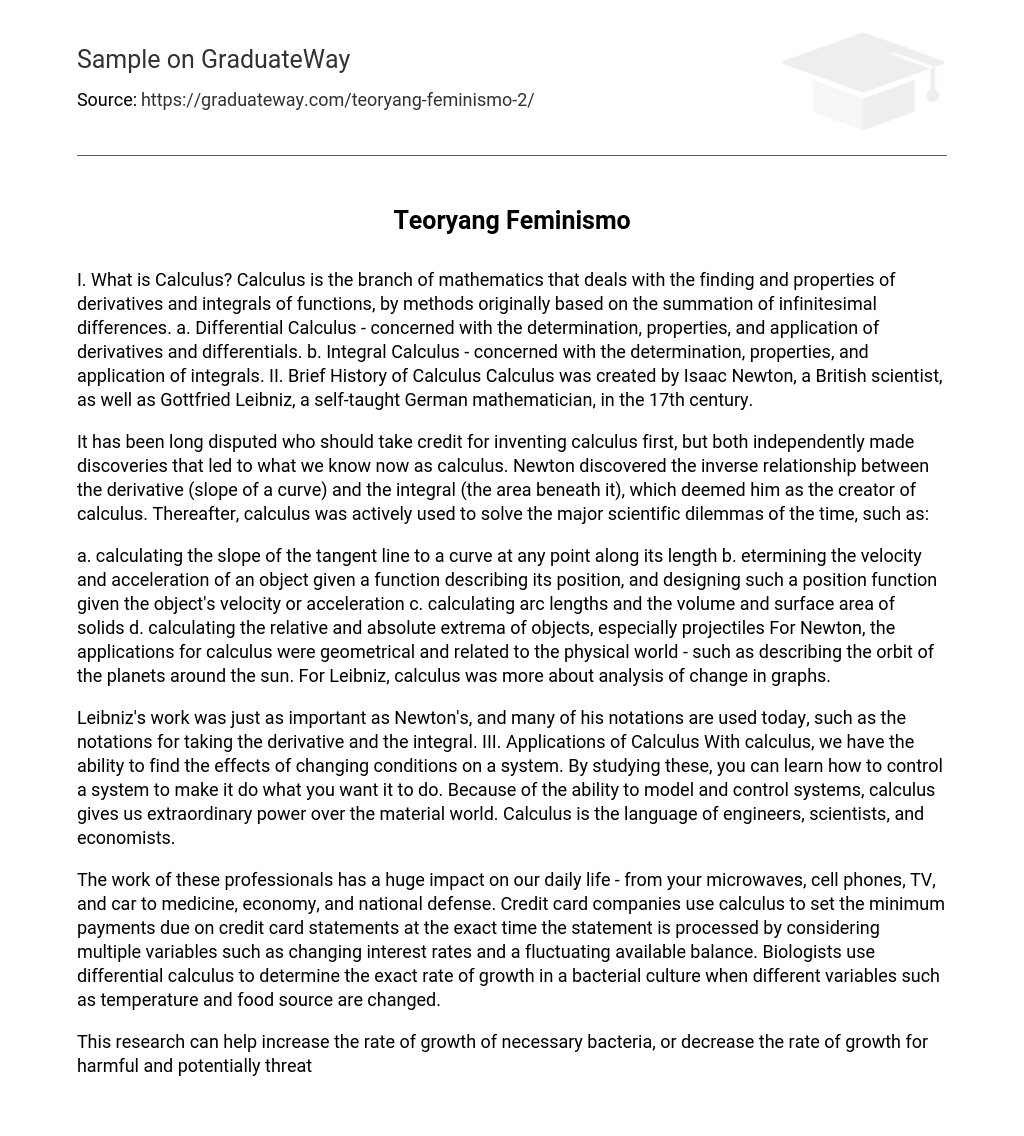I. What is Calculus? Calculus is the branch of mathematics that deals with the finding and properties of derivatives and integrals of functions, by methods originally based on the summation of infinitesimal differences. a. Differential Calculus – concerned with the determination, properties, and application of derivatives and differentials. b. Integral Calculus – concerned with the determination, properties, and application of integrals. II. Brief History of Calculus Calculus was created by Isaac Newton, a British scientist, as well as Gottfried Leibniz, a self-taught German mathematician, in the 17th century.
It has been long disputed who should take credit for inventing calculus first, but both independently made discoveries that led to what we know now as calculus. Newton discovered the inverse relationship between the derivative (slope of a curve) and the integral (the area beneath it), which deemed him as the creator of calculus. Thereafter, calculus was actively used to solve the major scientific dilemmas of the time, such as:
a. calculating the slope of the tangent line to a curve at any point along its length b. etermining the velocity and acceleration of an object given a function describing its position, and designing such a position function given the object’s velocity or acceleration c. calculating arc lengths and the volume and surface area of solids d. calculating the relative and absolute extrema of objects, especially projectiles For Newton, the applications for calculus were geometrical and related to the physical world – such as describing the orbit of the planets around the sun. For Leibniz, calculus was more about analysis of change in graphs.
Leibniz’s work was just as important as Newton’s, and many of his notations are used today, such as the notations for taking the derivative and the integral. III. Applications of Calculus With calculus, we have the ability to find the effects of changing conditions on a system. By studying these, you can learn how to control a system to make it do what you want it to do. Because of the ability to model and control systems, calculus gives us extraordinary power over the material world. Calculus is the language of engineers, scientists, and economists.
The work of these professionals has a huge impact on our daily life – from your microwaves, cell phones, TV, and car to medicine, economy, and national defense. Credit card companies use calculus to set the minimum payments due on credit card statements at the exact time the statement is processed by considering multiple variables such as changing interest rates and a fluctuating available balance. Biologists use differential calculus to determine the exact rate of growth in a bacterial culture when different variables such as temperature and food source are changed.
This research can help increase the rate of growth of necessary bacteria, or decrease the rate of growth for harmful and potentially threatening bacteria. An electrical engineer uses integration to determine the exact length of power cable needed to connect two substations that are miles apart. Because the cable is hung from poles, it is constantly curving. Calculus allows a precise figure to be determined. An architect will use integration to determine the amount of materials necessary to construct a curved dome over a new sports arena, as well as calculate the weight of that dome and determine the type of support structure required.
Space flight engineers frequently use calculus when planning lengthy missions. To launch an exploratory probe, they must consider the different orbiting velocities of the Earth and the planet the probe is targeted for, as well as other gravitational influences like the sun and the moon. Calculus allows each of those variables to be accurately taken into account. A physicist uses calculus to find the center of mass of a sports utility vehicle to design appropriate safety features that must adhere to federal specifications on different road surfaces and at different speeds.
An operations research analyst will use calculus when observing different processes at a manufacturing corporation. By considering the value of different variables, they can help a company improve operating efficiency, increase production, and raise profits. A graphics artist uses calculus to determine how different three-dimensional models will behave when subjected to rapidly changing conditions. This can create a realistic environment for movies or video games. Obviously, a wide variety of careers regularly use calculus.
Universities, the military, government agencies, airlines, entertainment studios, software companies, and construction companies are only a few employers who seek individuals with a solid knowledge of calculus. Even doctors and lawyers use calculus to help build the discipline necessary for solving complex problems, such as diagnosing patients or planning a prosecution case. Despite its mystique as a more complex branch of mathematics, calculus touches our lives each day, in ways too numerous to calculate. [Reference: http://www. wyzant. com/resources/lessons/math/calculus/]





